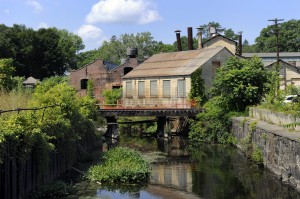Georgetown wire mill redevelopment languishes in litigation
The Gilbert & Bennet Wire Mill in Georgetown has sat silent since the company transferred its manufacturing operations out of state in 1989, ending 171 years of industrial production in the Fairfield County village. In the decades since, a plan to redevelop the 55-acre industrial site as a transit-oriented residential and commercial complex has languished with no clear path forward in sight.
“People in Redding ask, ”˜Will this be done in my lifetime?”™” said Julia Pemberton, first selectman in the town of Redding, in which a portion of the village of Georgetown and the long-vacant mill are located.
Purchased by the Georgetown Land Development Co. in 2002, the mill site originally was to be redeveloped with 416 housing units, including single-family homes, townhouses, lofts, apartments and affordable housing and up to 270,000 square feet of retail, restaurant and commercial office space.
The original plan also called for the construction of a performing arts center in addition to the project”™s main attraction, a new Georgetown train station to provide service on Metro-North Railroad”™s Danbury rail line.
The Connecticut Department of Transportation estimated the project would yield 1,500 new jobs and early economic impact studies estimated $5 million in yearly revenue for the town of Redding once the development reached full occupancy.
Plans for the station have been approved by state transportation officials but the question of funding still remains a major impediment, as does a mountain of debt that has stalled the entire project in recent years.
Also yet to be fully addressed are industrial waste residues on the site, which will require an environmental cleanup but currently do not pose any threat of exposure, Pemberton said.
The ambitious redevelopment project came to a legal halt in recent years as more than $3 million in back taxes and interest have accrued, leading the town to initiate foreclosure proceedings against Georgetown Land Development Co. in July 2014. Thirteen other defendants, including contractors and lienholders, are named in the lawsuit.
“At this point, the foreclosure is in and of itself a means of moving the project forward,” Pemberton said. “At the same time we are also hoping a negotiation continues with the parties, but when you go back to the original project”™s timeline there was a 10-year buildout for this project.”

- The old Gilbert & Bennett wire company in Redding, Conn., Thursday, August 7, 2014. Photo by Carol Kaliff.
If the legal impasse is resolved, the project has the potential to be transformative not only for the town of Redding, but the surrounding towns of Ridgefield, Wilton and Weston which share borders in close proximity to the wire mill, Pemberton said.
“Young people are getting priced out of Stamford and Norwalk, so where are they going to look ”” they are going to look north,” she said. “It will add a lot both in terms of the cultural, business and residential quality of the town and as an asset in a rural community. To have the best of both worlds here would make Redding that much more desirable.”
Pemberton said she is hopeful that the deadlock can be broken and that the developer, town and involved parties can move forward with the project.
Christopher Lynch, a consultant working with the land development company, said the company is as interested in developing the project as the town is.
“We are committed to seeing the project move forward. We have a fiduciary responsibility to protect the interest of our creditors,” he said. “I think everyone involved has the same goal of wanting to see this project move forward in a manner close to or consistent with the approved master plan.”
Both Pemberton and Lynch acknowledged that whoever proceeds with the development of the wire mill will likely need to revisit the original plans to fit with a vastly different economy from a decade ago.
“I have been told by many developers that our master plan is not viable in today”™s market,” Pemberton said.
